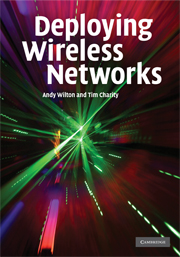Book contents
- Frontmatter
- Contents
- Foreword by Sir David Brown, FREng
- Preface
- Acknowledgements
- Authors' disclaimer
- 1 Introduction
- 2 Wireless network systems
- 3 Principles of access network planning
- 4 Introduction to RAN planning and design
- 5 GSM RAN planning and design
- 6 UMTS RAN planning and design
- 7 Cellular OFDM RAN planning and design
- 8 Mesh network planning and design
- 9 Core network and transmission
- 10 Network operation and optimisation
- Acronyms
- Index
- References
3 - Principles of access network planning
Published online by Cambridge University Press: 13 August 2009
- Frontmatter
- Contents
- Foreword by Sir David Brown, FREng
- Preface
- Acknowledgements
- Authors' disclaimer
- 1 Introduction
- 2 Wireless network systems
- 3 Principles of access network planning
- 4 Introduction to RAN planning and design
- 5 GSM RAN planning and design
- 6 UMTS RAN planning and design
- 7 Cellular OFDM RAN planning and design
- 8 Mesh network planning and design
- 9 Core network and transmission
- 10 Network operation and optimisation
- Acronyms
- Index
- References
Summary
In Chapters 1 and 2, the drivers for the development of the cellular system architecture were discussed and an overview of the key network elements and principles of operation for a GSM cellular solution was provided. The remainder of the book will address the activities necessary to design and deploy profitable wireless networks. Figure 3.1 summarises where these key processes are to be found by chapter.
In this chapter, the principles and processes that are used to plan wireless access networks will be developed. The major focus will be on cellular networks, as these usually represent the most complex planning cases, but an overview of the corresponding processes for 802.11 is also provided. Circuit voice networks will be examined initially; the treatment will then be extended to understand the additional considerations that come into play as first circuit-data and subsequently packet-data-based applications are introduced.
With the planning sequence understood, the way in which information from such processes can be used to explore the potential profitability of networks well in advance of deployment will be addressed. Choices regarding which applications are to be supported in the network and the quality of service offered will be shown to have a major impact on the profitability of network projects.
Circuit voice networks
In most forms of retailing, the introduction of new products follows the ‘S curve’ sequence first recognised by Rogers [1].
Information
- Type
- Chapter
- Information
- Deploying Wireless Networks , pp. 45 - 81Publisher: Cambridge University PressPrint publication year: 2008
